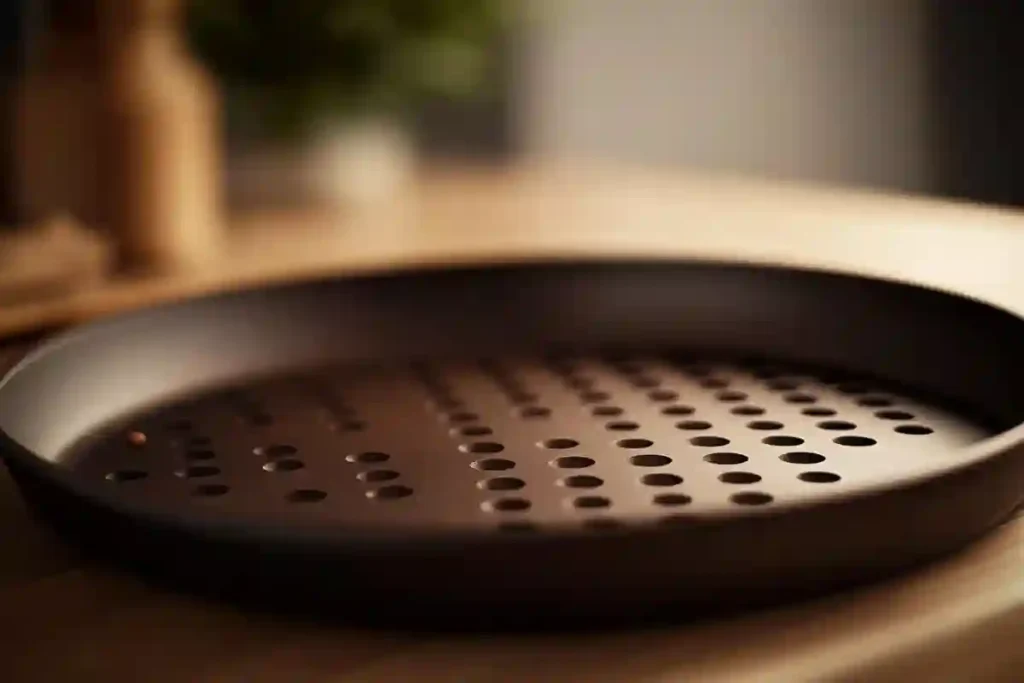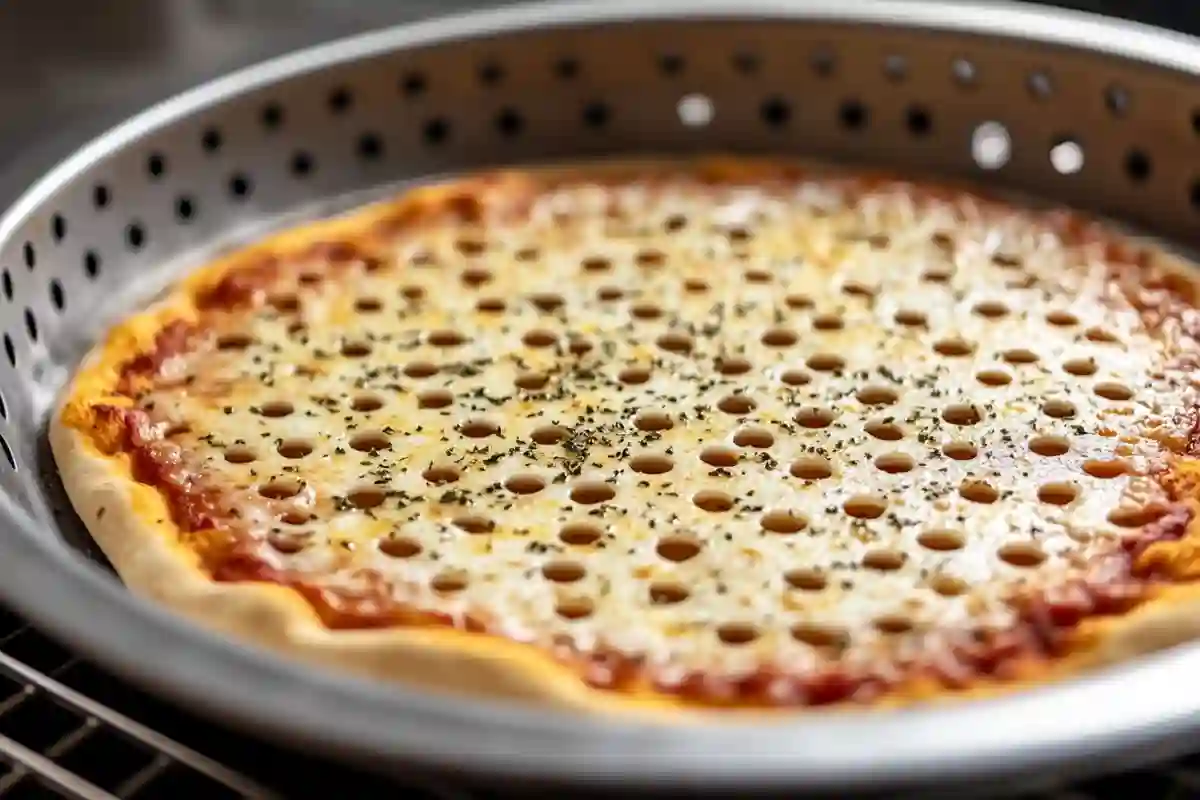When it comes to baking the perfect pizza at home, the choice of tools can make a significant difference. One tool that often sparks debate is the pizza pan with holes, also known as a perforated pizza pan. This article dives deep into the pros and cons of this kitchen essential, helping you determine if it’s the right choice for your pizza-making needs. Moreover, we will explore the science, practical tips, and alternative tools to ensure you have all the information you need to make an informed decision.

Why Do Pizza Pans Have Holes?
Perforated pizza pans are designed with small holes to improve airflow during the baking process. This unique design offers several benefits:
- Crispier Crusts: The holes allow hot air to circulate directly around the dough, ensuring a crispier crust.
- Faster Cooking: Improved airflow results in faster cooking times.
- Even Baking: The perforations promote uniform heat distribution, reducing the chances of undercooked or overcooked spots.
Conversely, traditional solid pizza pans lack these features, which may result in softer crusts. Understanding these differences is crucial to deciding whether a pizza pan with holes is better for your style of cooking. The added airflow not only enhances crust quality but also makes these pans a favorite for thin-crust pizza lovers. Additionally, perforated pans can support a variety of baking styles, making them versatile tools in any kitchen.
The Science Behind Perforated Pizza Pans
The small perforations in pizza pans serve a practical purpose rooted in physics. When heat interacts with the pizza dough, moisture is released. In traditional pans, this moisture may become trapped, resulting in a soggy crust. However, the holes in a perforated pan allow this moisture to escape. Additionally, the direct exposure of the dough to hot air or oven heat caramelizes the outer layer more effectively. This process not only creates a crispy texture but also enhances the flavor of the crust, making each bite more satisfying. Moreover, the science of convection plays a key role here, as the increased airflow circulates heat evenly across the pan’s surface, preventing hotspots or uneven baking. This scientific advantage is why many home chefs prefer perforated pans for their efficiency. It ensures consistent results, whether you’re making a simple Margherita or a complex gourmet pizza.
Benefits of Using a Perforated Pizza Pan
1. Enhanced Crust Texture
A perforated pizza pan is ideal for those who prefer a crispy crust. The design ensures:
- Less moisture buildup.
- A golden-brown, crunchy texture.
The crispy crust achieved using these pans can rival that of professional pizzerias. This makes it an excellent choice for thin-crust pizza enthusiasts and anyone who appreciates a firm base that doesn’t turn soggy under toppings. Additionally, the perforations allow the bottom of the crust to achieve an even bake, ensuring that each bite has a delightful crunch. When combined with high-quality ingredients and proper baking techniques, the results can be truly restaurant-quality. The perforations also encourage the crust to brown evenly, adding a visual appeal to your pizza that matches its delicious taste.
2. Faster Baking Times
With holes facilitating better airflow, pizzas cook faster. This is particularly beneficial when making multiple pizzas in succession. The shorter baking time ensures the toppings do not overcook while the crust achieves the perfect balance of crispiness and softness. For busy weeknights or parties, the time saved can be invaluable. Faster baking also means energy efficiency, as your oven doesn’t need to stay on as long. For those who value both speed and sustainability, this is a significant advantage. Moreover, the faster bake time reduces the risk of burning delicate toppings like fresh basil or soft cheeses. The quick cooking process also locks in flavors more effectively, making each pizza slice more flavorful.
3. Healthier Cooking
Perforations allow excess grease to drip away, resulting in a lighter, less oily pizza. This feature is especially useful when working with toppings like pepperoni, sausage, or cheese, which tend to release oils during cooking. By reducing the overall grease content, perforated pans contribute to healthier and more enjoyable meals. Additionally, the reduced oil content means fewer calories, making it easier to enjoy pizza without guilt. This health-focused benefit appeals to those who want to balance indulgence with mindful eating habits. Furthermore, the crispier texture achieved with less grease enhances the overall taste and presentation. Health-conscious cooks can also experiment with whole-grain or cauliflower crusts, which bake exceptionally well on perforated pans.
4. Versatility
These pans work well for various types of pizza, including thin crust, Neapolitan, and flatbreads. While they may not be suitable for deep-dish styles, their flexibility in handling diverse recipes makes them a must-have for home chefs who enjoy experimenting with different pizza styles and flavors. In addition, perforated pans can also be used for reheating leftover pizza, ensuring it remains crispy rather than soggy. The pan’s lightweight design makes it easy to handle, even for beginner cooks. Overall, the versatility of these pans makes them an excellent addition to any kitchen. They can also double as trays for other baked goods like cookies or pastries, adding to their usefulness.
Drawbacks of Perforated Pizza Pans
While pizza pans with holes offer many benefits, they also have drawbacks:
- Dough Leakage: Soft or thin dough may seep through the holes.
- Limited Versatility: Not ideal for deep-dish pizzas or recipes requiring more support.
- Cleaning Challenges: Residual cheese or sauce can get stuck in the holes, making cleanup more difficult.
Cleaning Tips for Perforated Pizza Pans
Cleaning a perforated pizza pan can be tricky due to the small holes. To simplify the process:
- Soak the pan in warm, soapy water immediately after use.
- Use a soft-bristled brush or toothbrush to remove stuck-on debris.
- Avoid abrasive cleaners, which may damage the pan’s surface.
- Dry the pan thoroughly to prevent rust or water spots. By following these steps, you can maintain the quality and longevity of your perforated pan. If stubborn stains persist, consider using a baking soda paste as a natural cleaner. Proper maintenance not only extends the life of the pan but also ensures consistent baking results every time. For best results, clean the pan promptly after each use to prevent stubborn buildup.
Comparing with Solid Pizza Pans
For certain styles, such as Chicago deep-dish or stuffed pizzas, a solid pizza pan is the better choice due to its sturdiness and containment. Solid pans excel in creating a softer, thicker crust and are better suited for recipes that require longer cooking times or heavier toppings. The lack of perforations provides better support for doughs with high moisture content, ensuring they bake evenly without leaking. However, solid pans may result in less airflow and longer bake times, which can impact the texture of thin-crust pizzas. By understanding these distinctions, you can choose the right pan based on the type of pizza you wish to create. Each pan has its strengths, and selecting the right one can make a significant difference in your final dish.
How to Use a Perforated Pizza Pan Effectively
To get the best results from a pizza pan with holes:
- Prepare the Dough Properly: Ensure it’s firm enough to prevent sagging through the holes.
- Use Parchment Paper (Optional): For sticky or fragile doughs, placing parchment paper can help.
- Preheat the Pan: Heating the pan beforehand enhances crust crispness.
- Watch the Bake Time: Check the pizza frequently, as cooking times are shorter.
Additionally, when using toppings with high moisture content, consider lightly pre-cooking them to prevent the crust from becoming soggy. This technique ensures that every ingredient cooks evenly while maintaining the desired texture of the crust. Preheating the pan is particularly important for achieving a consistent bake, as it ensures the dough begins to cook immediately upon contact with the hot surface. For a professional touch, consider sprinkling cornmeal on the pan before adding the dough to enhance the crust’s flavor and texture.
Alternative Tools for Crispy Pizza
If a perforated pizza pan isn’t for you, consider these alternatives:
- Pizza Stone: Known for evenly distributing heat and delivering crispy results.
- Cast Iron Pan: Versatile and excellent for achieving a crusty bottom.
- Air Fryer Pizza Tray: Designed to maximize airflow for ultra-crispy crusts.
Each tool has its pros and cons, but all serve as viable substitutes depending on your preferences.
Pizza Stones vs. Perforated Pans
Pizza stones are often compared to perforated pans due to their ability to create crispy crusts. While stones provide superior heat retention and even cooking, they require longer preheating times and are heavier to handle. In contrast, perforated pans offer convenience and faster cooking, making them a preferred choice for quick meals. However, pizza stones excel in retaining heat even after the pizza is removed, making them ideal for serving directly from the oven. The choice ultimately depends on your priorities: speed and convenience or heat retention and presentation. Both tools are excellent for enhancing your pizza-making skills and delivering satisfying results.
Frequently Asked Questions (FAQs)
1. Is a pizza pan with holes better for all types of pizza?
Not necessarily. Perforated pans excel for thin and crispy pizzas but are less suitable for deep-dish styles. Each pan type caters to specific preferences and recipes.
2. How do you clean a perforated pizza pan?
To clean, soak the pan in warm, soapy water to loosen debris, then scrub gently with a non-abrasive brush. Regular maintenance prevents residue buildup.
3. Do perforated pans work in all ovens?
Yes, they work in conventional, convection, and toaster ovens. Their versatility makes them suitable for various oven types.
4. Can I use aluminum foil with a perforated pan?
Using aluminum foil can block airflow, defeating the purpose of the holes. Parchment paper is a better option as it preserves the pan’s functionality.
5. How do I prevent cheese and toppings from sticking?
Grease the pan lightly with oil or cooking spray before placing the pizza. This step reduces sticking and simplifies cleanup.
Additional Sections
6. History of Pizza Pans
Pizza pans have evolved significantly over the years. From the early days of flat stones used in brick ovens to today’s high-tech perforated pans, the journey has been fascinating. Originally, people relied on basic tools like clay plates or cast iron griddles. As technology improved, aluminum and steel pans became common. These materials offered lighter weight and better heat conductivity. Perforated pans were introduced in the late 20th century as a way to mimic the crispy textures achieved by traditional pizza ovens. Modern pizza pans continue to innovate with materials like non-stick coatings and heat-resistant designs. This historical progression highlights how pizza-making tools have adapted to meet the needs of home chefs.
7. Types of Perforated Pizza Pans
Perforated pizza pans come in various types, including heavy-duty steel, aluminum, and even ceramic. Some have raised edges, while others are completely flat. The choice depends on the kind of pizza you want to make. Heavy-duty steel pans are perfect for professional-level baking, offering durability and heat retention. Aluminum pans are lightweight and ideal for quick cooking. Ceramic pans, though less common, provide excellent heat distribution. Some pans also feature additional coatings for non-stick properties. Each type serves a specific purpose, allowing bakers to customize their tools based on their needs.
8. Choosing the Right Pizza Pan
Selecting the right pizza pan requires careful consideration. Factors like material, size, and intended use play a crucial role. For crispy thin crusts, perforated aluminum pans are a great choice. For thicker pizzas, solid pans or cast iron pans offer better support. The size of the pan should match your oven’s capacity and your typical pizza size. If you plan to bake frequently, investing in a high-quality, durable pan is worth it. Additionally, consider pans with non-stick surfaces for easier cleaning and maintenance. Researching product reviews and expert opinions can help you make an informed decision.
9. Common Pizza Baking Mistakes
Even with the best tools, mistakes can happen. One common issue is overloading the pizza with toppings, which can make the crust soggy. Using cold dough is another mistake that can lead to uneven baking. Preheating the oven and pan is essential for achieving a crispy crust. Avoid baking the pizza on a low rack, as this can result in undercooked dough. Using the wrong type of pan for your desired pizza style is another frequent error. By being aware of these common pitfalls, you can improve your baking skills and consistently produce delicious pizzas.
10. Professional Insights
Professional chefs often share tips that elevate pizza-making. Many recommend using perforated pans for achieving restaurant-quality results at home. They stress the importance of preheating both the oven and pan to ensure even baking. Another tip is to use high-quality ingredients, as the pan’s effectiveness is enhanced when paired with good dough and fresh toppings. Chefs also suggest experimenting with different pans to find the one that works best for your style. For a pro-level touch, adding a finishing drizzle of olive oil or a sprinkle of fresh herbs post-baking enhances flavor and presentation. Listening to professional advice can transform your pizza-making experience.
Conclusion
Is a pizza pan with holes better? The answer depends on your pizza preferences. For crispy crust lovers, a perforated pizza pan is an excellent choice. It promotes even baking, reduces cooking time, and enhances texture. However, if you favor thicker, deep-dish styles or prioritize easy cleanup, a solid pan might be more suitable. Consider your needs and experiment to find the best fit for your kitchen. Ultimately, the right tools and techniques can elevate your homemade pizza game, making every meal a delightful experience. Whether you’re a seasoned chef or a home cook, the right pan can make all the difference in crafting the perfect pizza.
Related article : Pizza Pan: How to Choose the Best One

